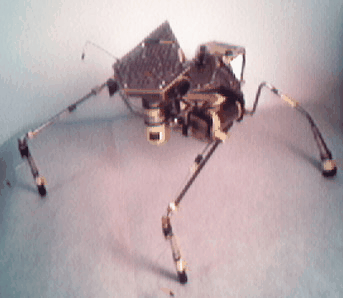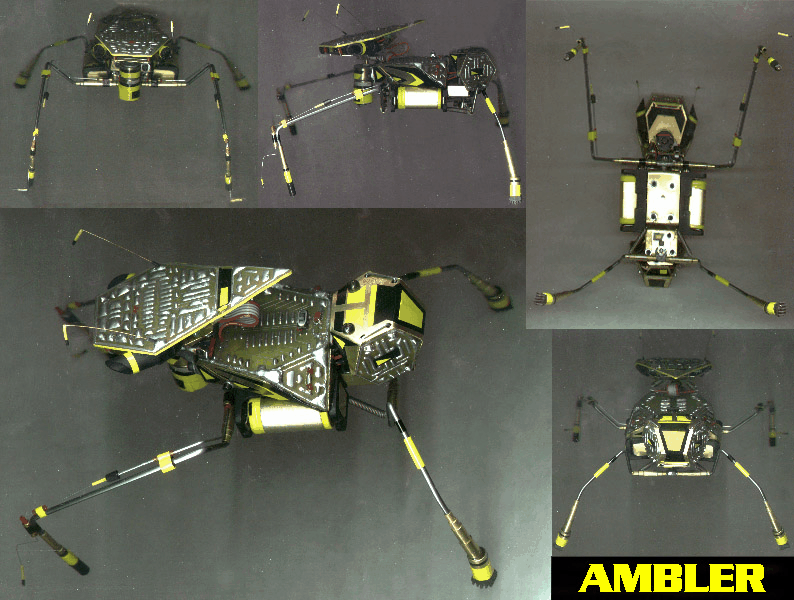AQUABOTS CARBOTS PHOTOVORES PLANTS SYMETS OTHER STUFF TUTORIALS WALKERS LINKS




AQUABOTS CARBOTS PHOTOVORES PLANTS SYMETS OTHER STUFF TUTORIALS WALKERS LINKS
| HOME AQUABOTS CARBOTS PHOTOVORES PLANTS SYMETS OTHER STUFF TUTORIALS WALKERS LINKS |
||||||||||||||||||||

|
||||||||||||||||||||
| Ambler is a two motor positively phototropic walker with a 1DOF head. It is configured with the front or master motor shaft parallel to the ground and the rear or slave motor perpendicular to the ground. The front motor produces only lift and the rear motor produces only forward thrust. This layout isn't the fastest or most graceful, but I chose it because it can be made to turn quite easily. It's power supply consists of two 3 volt batteries slung low on the frame. Ambler walks forward, is aggresively positively phototropic and reverses via two tactile sensors. | ||||||||||||||||||||

|
||||||||||||||||||||
| Ambler's frame and body panels are all made from sheet brass and brass tubing. The entire bot is made from prefabricated brass parts that are bolted together. The PCBs are experimental and were custom wired for this bot. The controller is Justin's Hemicore circuit. The head is Wilf's Power Smart Head rewired to bias the inputs of the Hemicore. The head causes longer or shorter pulses on one side or the other of the walking gait, depending on light levels, causing the bot to turn toward the light. Ambler uses dual H-bridges as motor drivers. This critter is a little heavy and therefore it has a fairly large turning radius. The photoresistor eyes are inside of 1/2 inch tubes to limit the bots field of view. This gives it a more accurate lock on light sources and screens out ambient light. It is really amazing to watch the head turn toward the light source and then see the bot turn slowly toward it. The leg gearmotors are Nihon or what is commonly called BG Micros. The head motor is salvaged from an old camcorder. The legs are 1/8 inch steel rod tipped with brass tubing. | ||||||||||||||||||||

|
||||||||||||||||||||
| The back legs terminate into progressivly larger pieces of brass tubing. The last piece is angled sharply to produce a good grip angle on the surface. To enhance this grip throughout the walking gait, a small, ribbed, rubber pad was installed. The material is cut from offset press pinch rollers and is very good at keeping the bots foot planted. | ||||||||||||||||||||
| The front legs are tipped with miniature shock absorbers. The smaller brass tube slips into the larger tube which contains a small spring. The foot can compress about 3/8 of an inch but, usually only goes about a 1/16 of an inch when the leg comes down on it during walking. The tactile sensors run down each front leg and hook over the front through a small brass tube. When the wire is deflected it touches the inside of the tube completing the circuit and the bot backs up. | ||||||||||||||||||||

|
||||||||||||||||||||
| The head proved to be a difficult bit of mechanics. The problem was that the head would track the light as the body kept going straight. The further the body went the further back the head would move until the bot was doing this strange sideways look as it eventually lost sight of the light source. Blinders kept the head from moving to far back, but interfered with the phototropic response. The solution, which I have to thank Dennison for, was to place springs on the head to limit it's travel through compliance. The springs slowly stop the head and prevent it from locking on. This allows the head to continually bias the body to turn toward the light. The dramatic look of a head seeking out the light source or changing direction when another light is presented is worth the effort. | ||||||||||||||||||||
| This is a closeup of the triangular PCBs which contain the LED indicators. They flash the rythym of the bots brain, master on the left, and slave on the right. The head also has two green LED indicators. | ||||||||||||||||||||
| HOME AQUABOTS CARBOTS PHOTOVORES PLANTS SYMETS OTHER STUFF TUTORIALS WALKERS LINKS |
||||||||||||||||||||